Engage NY Eureka Math Precalculus Module 3 Lesson 3 Answer Key
Eureka Math Precalculus Module 3 Lesson 3 Exploratory Challenge Answer Key
Exploratory Challenge
Consider the equation x3 = 1.
a. Use the graph of f(x) = x3 – 1 to explain why 1 is the only real number solution to the equation x3 = 1.

Answer:
From the graph, you can see that the point (1,0) is the x – intercept of the function. That means that 1 is a zero of the polynomial function and thus is a solution to the equation x3 – 1 = 0.
b. Find all of the complex solutions to the equation x3 = 1. Come up with as many methods as you can for finding the solutions to this equation.
Answer:
Method 1: Factoring Using a Polynomial Identity and Using the Quadratic Formula
Rewrite the equation in the form x3 – 1 = 0, and use the identity a3 – b3 = (a – b)(a2 + ab + b2) to factor x3 – 1.
x3 – 1 = 0
(x – 1)(x2 + x + 1) = 0
Then
x – 1 = 0 or x2 + x + 1 = 0.
The solution to the equation x – 1 = 0 is 1. The quadratic formula gives the other solutions.
x = \(\frac{ – 1 \pm \sqrt{ – 3}}{2}\) = \(\frac{ – 1 \pm i \sqrt{3}}{2}\)
So, the solution set is
{1, – \(\frac{1}{2}\) + \(\frac{\sqrt{3}}{2}\) i, – \(\frac{1}{2}\) – \(\frac{\sqrt{3}}{2}\) i}.
Method 2: Using the Polar Form of a Complex Number
The solutions to the equation x3 = 1 are the cube roots of 1.
The number 1 has modulus 1 and argument 0 (or any rotation that terminates along the positive real axis such as 2π or 4π, etc.).
The modulus of the cube roots of 1 is \(\sqrt[3]{1}\) = 1. The arguments are solutions to
3θ = 0
3θ = 2π
3θ = 4π
3θ = 6π.
The solutions to these equations are 0, \(\frac{2\pi}{3}\), \(4\frac{\pi}{3}\), 2π, …. Since the rotations cycle back to the same locations in the complex plane after the first three, we only need to consider 0, \(\frac{2\pi}{3}\), and \(\frac{4\pi}{3}\).
The solutions to the equation x3 = 1 are
1(cos(0) + i sin(0) ) = 1
1(cos(\(\frac{2\pi}{3}\)) + i sin(\(\frac{2\pi}{3}\))) = – \(\frac{1}{2}\) + \(\frac{\sqrt{3}}{2}\) i
1(cos(\(\frac{4\pi}{3}\)) + i sin(\(\frac{4\pi}{3}\))) = – \(\frac{1}{2}\) – \(\frac{\sqrt{3}}{2}\) i.
Method 3: Using the Techniques of Lessons 1 and 2 from This Module
Let x = a + bi; then (a + bi)3 = 1 + 0i.
Expand (a + bi)3, and equate the real and imaginary parts with 1 and 0.
(a + bi)3 = (a + bi)(a2 + 2abi – b2) = a3 + 3a2 bi – 3ab2 – b3 i
The real part of (a + bi)3 is a3 – 3ab2, and the imaginary part is 3a3 b – b3. Thus, we need to solve the system
a3 – 3ab2 = 1
3a2 b – b3 = 0.
Rewriting the second equation gives us
b(3a2 – b2) = 0.
If b = 0, then a3 = 1 and a = 1. So, a solution to the equation x3 = 1 is 1 + 0i = 1.
If 3a2 – b2 = 0, then b2 = 3a2, and by substitution,
a3 – 3a(3a2 ) = 1
– 8a3 = 1
a3 = – \(\frac{1}{8}\) .
This equation has one real solution: – \(\frac{1}{2}\). If = – \(\frac{1}{2}\), then b2 = 3 ( – \(\frac{1}{2}\))2 = \(\frac{3}{4}\), so b = \(\frac{\sqrt{3}}{2}\) or = – \(\frac{\sqrt{3}}{2}\). The other two solutions to the equation x3 = 1 are – \(\frac{1}{2}\) + \(\frac{\sqrt{3}}{2}\) i and – \(\frac{1}{2}\) – \(\frac{\sqrt{3}}{2}\) i.
Eureka Math Precalculus Module 3 Lesson 3 Exercise Answer Key
Opening Exercise
Consider the equation xn = 1 for positive integers n.
a. Must an equation of this form have a real solution? Explain your reasoning.
Answer:
The number 1 will always be a solution to xn = 1 because 1n = 1 for any positive integer n.
b. Could an equation of this form have two real solutions? Explain your reasoning.
Answer:
When n is an even number, both 1 and – 1 are solutions. The number 1 is a solution because 1n = 1 for any positive integer. The number – 1 is a solution because ( – 1)n = ( – 1)2k where k is a positive integer if n is even and
( – 1)2k = (( – 1)2)k = 1k = 1.
c. How many complex solutions are there for an equation of this form? Explain how you know.
Answer:
We can rewrite the equation in the form xn – 1 = 0. The solutions to this polynomial equation are the roots of the polynomial p(x) = xn – 1. The fundamental theorem of algebra says that the polynomial
p(x) = xn – 1 factors over the complex numbers into the product of n linear terms. Each term identifies a complex root of the polynomial. Thus, a polynomial equation of degree n has at most n solutions.
Exercises
Solutions to the equation xn = 1 for positive integers n are called the nth roots of unity.
Exercise 1.
What are the square roots of unity in rectangular and polar form?
Answer:
The square roots of unity in rectangular form are the real numbers 1 and – 1.
In polar form, 1(cos(0) + i sin(0) ) and 1(cos(π) + i sin(π) ).
Exercise 2.
What are the fourth roots of unity in rectangular and polar form? Solve this problem by creating and solving a polynomial equation. Show work to support your answer.
Answer:
The fourth roots of unity in rectangular form are 1, – 1, i, – i.
x4 = 1
x4 – 1 = 0
(x2 – 1)(x2 + 1) = 0
The solutions to x2 – 1 = 0 are 1 and – 1. The solutions to x2 + 1 = 0 are i and – i.
In polar form, 1(cos(0) + i sin(0) ), 1(cos(\(\frac{\pi}{2}\)) + i sin(\(\frac{\pi}{2}\)) ), 1(cos(π) + i sin(π) ), 1(cos(\(\frac{3\pi}{2}\)) + i sin(\(\frac{3\pi}{2}\)) ).
Exercise 3.
Find the sixth roots of unity in rectangular form by creating and solving a polynomial equation. Show work to support your answer. Find the sixth roots of unity in polar form.
Answer:
x6 – 1 = 0
(x3 + 1)(x3 – 1) = 0
(x + 1)(x2 – x + 1)(x – 1)(x2 + x + 1) = 0
By inspection, 1 and – 1 are sixth roots. Using the quadratic formula to find the solutions to x2 – x + 1 = 0 and x2 + x + 1 = 0 gives the other four roots: \(\frac{1}{2}\) + \(\frac{i \sqrt{3}}{2}\), \(\frac{1}{2}\) – \(\frac{i \sqrt{3}}{2}\), – \(\frac{1}{2}\) + \(\frac{i \sqrt{3}}{2}\), and – \(\frac{1}{2}\) – \(\frac{i \sqrt{3}}{2}\).
In polar form, 1(cos(0) + i sin(0) ), 1(cos(\(\frac{\pi}{3}\)) + i sin(\(\frac{\pi}{3}\)) ), (cos(\(\frac{2\pi}{3}\)) + i sin(\(\frac{2\pi}{3}\)) ), 1(cos(π) + i sin(π) ), 1(cos(\(\frac{4\pi}{3}\)) + i sin(\(\frac{4\pi}{3}\)) ), 1(cos(\(\frac{5\pi}{3}\)) + i sin(\(\frac{5\pi}{3}\)) ).
Exercise 4.
Without using a formula, what would be the polar forms of the fifth roots of unity? Explain using the geometric effect of multiplication complex numbers.
Answer:
The modulus would be 1 because dividing 1 into the product of six equal numbers still means each number must be 1. The arguments would be fifths of 2π, so 0, \(\frac{\pi}{5}\), \(\frac{2\pi}{5}\), \(3\frac{\pi}{5}\), and \(\frac{4\pi}{5}\). The fifth roots of z, when multiplied together, must equal z1 = z\(\frac{1}{5}\)∙z\(\frac{1}{5}\)∙z\(\frac{1}{5}\)∙z\(\frac{1}{5}\)∙z\(\frac{1}{5}\) . That would be like starting with the real number 1 and rotating it by \(\frac{1}{5}\) of 2π and dilating it by a factor of 1 so that you ended up back at the real number 1 after 5 repeated multiplications.
Discussion
What is the modulus of each root of unity regardless of the value of n? Explain how you know.
Answer:
The modulus is always 1 because the nth/sup> root of 1 is equal to 1. The points are on the unit circle, and the radius is always 1.
How could you describe the location of the roots of unity in the complex plane?
Answer:
They are points on a unit circle, evenly spaced every \(\frac{2\pi}{n}\) units starting from 1 along the positive real axis.
The diagram below shows the solutions to the equation x3 = 27. How do these numbers compare to the cube roots of unity (e.g., the solutions to x3 = 1)?
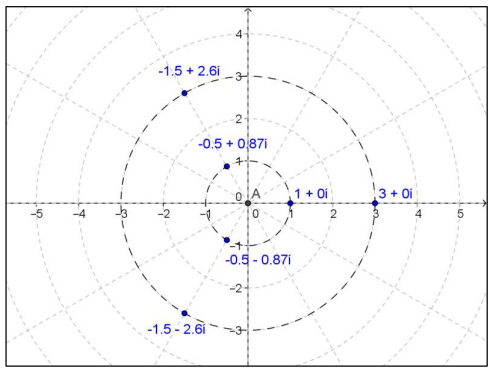
Answer:
They are points on a circle of radius 3 since the cube root of 27 is 3. Each one is a scalar multiple (by a factor of 3) of the cube roots of unity. Thus, they have the same arguments but a different modulus.
Eureka Math Precalculus Module 3 Lesson 3 Problem Set Answer Key
Question 1.
Graph the nth roots of unity in the complex plane for the specified value of n.
a. n = 3
Answer:
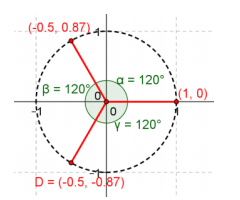
b. n = 4
Answer:
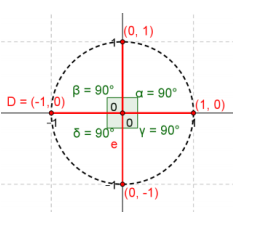
c. n = 5
Answer:
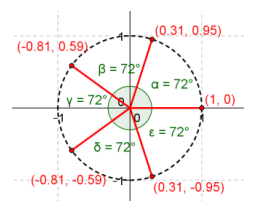
d. n = 6
Answer:
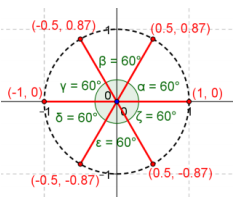
Question 2.
Find the cube roots of unity by using each method stated.
a. Solve the polynomial equation x3 = 1 algebraically.
Answer:
x3 – 1 = 0, (x – 1)(x2 + x + 1) = 0, x = 1, x2 + x + 1 = 0, x = \(\frac{ – 1 \pm \sqrt{1 – 4}}{2}\) = – \(\frac{1}{2}\)±\(\frac{\sqrt{3} i}{2}\)
The roots of unity are 1, – \(\frac{1}{2}\) + \(\frac{\sqrt{3}}{2}\) i, – \(\frac{1}{2}\) – \(\frac{\sqrt{3}}{2}\) i.
b. Use the polar form z3 = r(cos(θ) + sin(θ) ), and find the modulus and argument of z.
Answer:
z3 = 1, r3 = 1, r = 1
3θ = 0, 3θ = 2π, 3θ = 4π, …; therefore, θ = 0, \(\frac{2\pi}{3}\), \(\frac{4\pi}{3}\), 2π, …
z = \(\sqrt[3]{r}\)(cos(θ) + i sin(θ) )
z1 = 1(cos(0) + i sin(0) ) = 1
z2 = 1(cos(\(\frac{2\pi}{3}\)) + i sin(\(\frac{2\pi}{3}\)) ) = – \(\frac{1}{2}\) + \(\frac{\sqrt{3}}{2}\) i
z3 = 1(cos(\(\frac{4\pi}{3}\)) + i sin(\(\frac{4\pi}{3}\)) ) = – \(\frac{1}{2}\) – \(\frac{\sqrt{3}}{2}\) i
The roots of unity are 1, – \(\frac{1}{2}\) + \(\frac{\sqrt{3}}{2}\) i, – \(\frac{1}{2}\) – \(\frac{\sqrt{3}}{2}\) i.
c. Solve (a + bi)3 = 1 by expanding (a + bi)3 and setting it equal to 1 + 0i.
Answer:
(a + bi)3 = 1, a3 + 3a2 bi – 3ab2 – b3 i = 1; therefore, a3 – 3ab2 = 1 and 3a2 b – b3 = 0.
For 3a2 b – b3 = 0, b(3a2 – b2 ) = 0, we have either b = 0 or a2 – b2 = 0.
For b = 0, we substitute it in a3 – 3ab2 = 1, a3 = 1, a = 1; therefore, we have 1 + 0i.
For 3a2 – b2 = 0, b2 = 3a2, we substitute it in a3 – 3ab2 = 1, a3 – 9a3 = 1, a3 = – \(\frac{1}{8}\), a = – \(\frac{1}{2}\).
For = – \(\frac{1}{2}\), we substitute it in b2 = 3a2, and we get b = ±\(\frac{\sqrt{3}}{2}\). Therefore, we have \(\frac{1}{2}\) + \(\frac{\sqrt{3}}{2}\) i and \(\frac{1}{2}\) – \(\frac{\sqrt{3}}{2}\) i.
The roots of unity are 1, – \(\frac{1}{2}\) + \(\frac{\sqrt{3}}{2}\) i, – \(\frac{1}{2}\) – \(\frac{\sqrt{3}}{2}\) i.
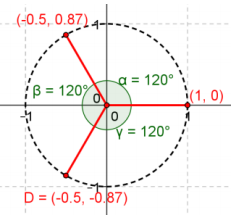
Question 3.
Find the fourth roots of unity by using the method stated.
a. Solve the polynomial equation x4 = 1 algebraically.
Answer:
x4 – 1 = 0, (x2 + 1)(x + 1)(x – 1) = 0, x = ±i, x = ±1
The roots of unity are 1, i, – 1, – i.
b. Use the polar form z4 = r(cos(θ) + sin(θ) ), and find the modulus and argument of z.
Answer:
z4 = 1, r4 = 1, r = 1
4θ = 0, 4θ = 2π, 4θ = 4π, 4θ = 6π, 4θ = 8π, …; therefore, θ = 0, \(\frac{\pi}{2}\), π, \(\frac{3\pi}{2}\), 2π, …
z = \(\sqrt[3]{r}\)(cos(θ) + i sin(θ) )
z1 = 1(cos(0) + i sin(0) ) = 1
z2 = 1(cos(\(\frac{\pi}{2}\)) + i sin(\(\frac{\pi}{2}\))) = i
z3 = 1(cos(π) + i sin(π) ) = – 1
z4 = 1(cos(\(\frac{3\pi}{2}\)) + i sin(\(\frac{3\pi}{2}\))) = – i
The roots of unity are 1, i, – 1, – i.
c. Solve (a + bi)4 = 1 by expanding (a + bi)4 and setting it equal to 1 + 0i.
Answer:
(a + bi)4 = 1, a4 + 4a3 bi – 6a2 b2 – 4ab3 i + b4 = 1.
Therefore, a4 – 6a2 b2 + b4 = 1 and 4a3 b – 4ab3 = 0.
For 4a3 b – 4ab3 = 0, 4ab(a2 – b2 ) = 0, we have either a = 0, b = 0, or a2 – b2 = 0.
For a = 0, we substitute it in a4 – 6a2 b2 + b4 = 1, b4 = 1, b = ±1; therefore, we have fourth roots of unity i and – i.
For b = 0, we substitute it in a4 – 6a2 b2 + b4 = 1, a4 = 1, a = ±1 for a. b∈R; therefore, we have fourth roots of unity 1 and – 1.
For a2 – b2 = 0, a2 = b2, we substitute it in a4 – 6a2 b2 + b4 = 1, b4 – 6b4 + b4 = 1, 4b4 = – 1; there is no solution for b for a. b∈R;
The roots of unity are 1, i, – 1, – i.

Question 4.
Find the fifth roots of unity by using the method stated.
Use the polar form z5 = r(cos(θ) + sin(θ) ), and find the modulus and argument of z.
Answer:
z5 = 1, r5 = 1, r = 1
5θ = 0, 5θ = 2π, 5θ = 4π, 5θ = 6π, 5θ = 8π, 5θ = 10π, …; therefore, θ = 0, \(\frac{2\pi}{5}\), \(\frac{4\pi}{5}\), \(\frac{6\pi}{5}\), \(\frac{8\pi}{5}\), 2π, …
z1 = 1(cos(0) + i sin(0) ) = 1
z2 = 1(cos(\(\frac{2\pi}{5}\)) + i sin(\(\frac{2\pi}{5}\)) ) = 0.309 + 0.951i
z3 = 1(cos(\(\frac{4\pi}{5}\)) + i sin(\(\frac{4\pi}{5}\)) ) = – 0.809 + 0.588i
z4 = 1(cos(\(\frac{6\pi}{5}\)) + i sin(\(\frac{6\pi}{5}\)) ) = – 0.809 – 0.588i
z5 = 1(cos(\(\frac{8\pi}{5}\)) + i sin(\(\frac{8\pi}{5}\)) ) = 0.309 – 0.951i
The roots of unity are 1, 0.309 + 0.951i, – 0.809 + 0.588i, – 0.809 – 0.588i, 0.309 – 0.951i, 1.

Question 5.
Find the sixth roots of unity by using the method stated.
a. Solve the polynomial equation x6 = 1 algebraically.
Answer:
x6 – 1 = 0, (x + 1)(x2 – x + 1)(x – 1)(x2 + x + 1) = 0, x = ±1, x = \(\frac{1}{2}\) ±\(\frac{\sqrt{3} i}{2}\), x = – \(\frac{1}{2}\) ±\(\frac{\sqrt{3} i}{2}\)
The roots of unity are 1, – 1, \(\frac{1}{2}\) + \(\frac{\sqrt{3} i}{2}\), \(\frac{1}{2}\) – \(\frac{\sqrt{3} i}{2}\), – \(\frac{1}{2}\) + \(\frac{\sqrt{3} i}{2}\), – \(\frac{1}{2}\) – \(\frac{\sqrt{3} i}{2}\).
b. Use the polar form z6 = r(cos(θ) + sin(θ) ), and find the modulus and argument of z.
Answer:
z6 = 1, r6 = 1, r = 1
6θ = 0, 6θ = 2π, 6θ = 4π, 6θ = 6π, 6θ = 8π, 6θ = 10π, 6θ = 12π, 6θ = 14π, …; therefore, θ = 0, \(\frac{\pi}{3}\), \(\frac{2}{3}\), π, \(\frac{4\pi}{3}\), \(\frac{5\pi}{3}\), 2π, \(\frac{7\pi}{3}\), …
z1 = 1(cos(0) + i sin(0) ) = 1
z2 = 1(cos(\(\frac{\pi}{3}\)) + i sin(\(\frac{\pi}{3}\)) ) = \(\frac{1}{2}\) + \(\frac{\sqrt{3}}{2}\) i
z3 = 1(cos(\(\frac{2\pi}{3}\)) + i sin(\(\frac{2\pi}{3}\)) ) = – \(\frac{1}{2}\) + \(\frac{\sqrt{3}}{2}\) i
z4 = 1(cos(π) + i sin(π) ) = – 1
z5 = 1(cos(\(\frac{4\pi}{3}\)) + i sin(\(\frac{4\pi}{3}\)) ) = – \(\frac{1}{2}\) – \(\frac{\sqrt{3}}{2}\) i
z6 = 1(cos(\(\frac{5\pi}{3}\)) + i sin(\(\frac{5\pi}{3}\)) ) = \(\frac{1}{2}\) – \(\frac{\sqrt{3}}{2}\) i
The roots of unity are 1, \(\frac{1}{2}\) + \(\frac{\sqrt{3}}{2}\) i, – \(\frac{1}{2}\) + \(\frac{\sqrt{3}}{2}\) i, – 1, – \(\frac{1}{2}\) – \(\frac{\sqrt{3}}{2}\) i, \(\frac{1}{2}\) + \(\frac{\sqrt{3}}{2}\) i.

Question 6.
Consider the equation xN = 1 where N is a positive whole number.
a. For which value of N does xN = 1 have only one solution?
Answer:
N = 1
b. For which value of N does xN = 1 have only ±1 as solutions?
Answer:
N = 2
c. For which value of N does xN = 1 have only ±1 and ±i as solutions?
Answer:
N = 4
d. For which values of N does xN = 1 have ±1 as solutions?
Answer:
Any even number N produces solutions ±1.
Question 7.
Find the equation that has the following solutions.
a.
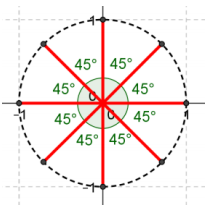
Answer:
x8 = 1
b.
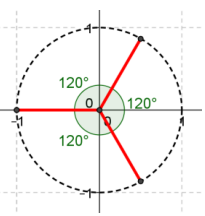
Answer:
x3 = – 1
c.
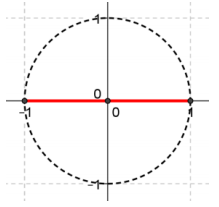
Answer:
x2 = 1
Question 8.
Find the equation (a + bi)N = c that has solutions shown in the graph below.
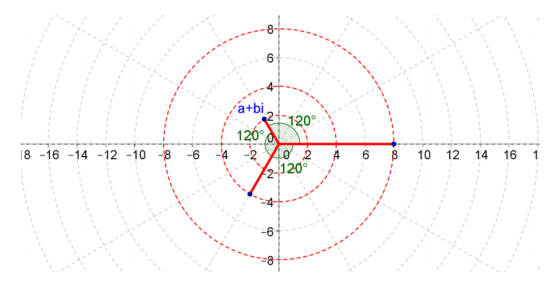
Answer:
( – 1 + \(\sqrt{3}\)i)3 = 8
Eureka Math Precalculus Module 3 Lesson 3 Exit Ticket Answer Key
Question 1.
What is a fourth root of unity? How many fourth roots of unity are there? Explain how you know.
Answer:
The fourth root of unity is a number that multiplied by itself 4 times is equal to 1. There are 4 fourth roots of unity. x4 = 1 results in solving the polynomial x4 – 1 = 0. The fundamental theorem of algebra guarantees four roots since that is the degree of the polynomial.
Question 2.
Find the polar form of the fourth roots of unity.
Answer:
For the fourth roots of unity, n = 4 and r = 1, so each root has modulus 1, and the arguments are 0, \(\frac{2\pi}{4}\), \(\frac{4\pi}{4}\), and \(\frac{6\pi}{4}\). We can rewrite the arguments as 0, \(\frac{\pi}{2}\), π, and \(\frac{3\pi}{2}\). Then, the fourth roots of unity are
x1 = cos(0) + i sin(0) = 1
x2 = cos(\(\frac{\pi}{2}\)) + i sin(\(\frac{\pi}{2}\)) = i
x3 = cos(π) + i sin(π) = – 1
x4 = cos(\(\frac{3\pi}{2}\)) + i sin(\(\frac{3\pi}{2}\)) = – i.
Question 3.
Write x4 – 1 as a product of linear factors, and explain how this expression supports your answers to Problems 1 and 2.
Answer:
Since there are four roots of unity, there should be four linear factors.
x4 – 1 = (x – 1)(x – i)(x + 1)(x + i)